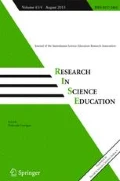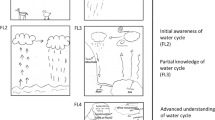Abstract
This paper explores the different types and characteristics of preschool children's explanations of plant growth and rain formation. The children's explanations were categorized as naturalistic, non-naturalistic, or synthetic, i.e., explanations containing both naturalistic and non-naturalistic parts. In regards to plant growth the children tended to rely on synthetic or on naturalistic explanations, which involved direct and indirect agents (such as water, a person, fertilizers, roots) enabling the plant to grow. Non-naturalistic explanations of plant growth, or the non-naturalistic parts of synthetic explanations, were mainly animistic (anthropomorphic). In the case of rain formation the children most frequently used non-naturalistic explanations, which were mainly teleological or metaphysical. The naturalistic explanations recorded on rain formation, as well as the naturalistic parts of synthetic explanations tended to have a non-agentive character, i.e., children considered rainwater as preexisting in containers such as the clouds. Overall, the explanations recorded about plant growth tended to be more complex than the ones for rain formation. It is suggested that science activities designed for preschool children should take into account the types and characteristics of their explanations in order to select which phenomena are appropriate for this age group, and aim at fostering the children's ability at formulating naturalistic explanations.
Similar content being viewed by others
References
Andersson, B. (1990). Pupils' conception of matter and its transformations (age 12–16). Studies in Science Education, 18, 53–85.
Backscheider, A. G., Shatz, M., & Gelman, S. A. (1993). Preschoolers' ability to distinguish living kinds as a function of regrowth. Child Development, 64, 1242–1257.
Bar, V. (1989). Children's views about the water cycle. Science Education, 73(4), 481–500.
Barker, M. (1995). A plant is an animal standing on its head. Journal of Biological Education, 29(3), 201–208.
Bell, B. (1985). Students' ideas about plant nutrition: What are they? Journal of Biological Education, 19(3), 213–218.
Berzonsky, M. D. (1971). The role of familiarity in children's explanations of physical causality. Child Development, 42, 705–715.
Blalock, H. M. (1987). Social statistics. Singapore: McGraw-Hill.
Brewer, W. F., Chinn, C. A., & Samarapungavan, A. (1998). Explanation in scientists and children. Minds and Machines, 8, 119–136.
Brosnan, T. (1990). Categorising macro and micro explanations of natural change. In P. L. Lijnse, P. Light, W. de Vos & A. J. Waarlo (Eds.), Proceedings of the Seminar Relating Macroscopic Phenomena to Microscopic Particles. A Central Problem in Secondary Science Education (pp. 198–211). Utrecht: CD-β Press.
Carey, S. (1985). Conceptual change in childhood. Cambridge: The MIT.
Carey, S., & Spelke, E. (1994). Domain-specific knowledge and conceptual change. In L. A. Hirschfeld & S. A. Gelman (Eds.), Mapping the mind: Domain specificity in cognition and culture (pp. 169–200). New York: Cambridge University Press.
Cumming, J. (2003). Do runner beans really make you run fast? Young children learning about science-related food concepts in informal settings. Research in Science Education, 33(4), 483–501.
Donaldson, M. L., & Elliot, A. (1990). Children's explanations. In R. Grieve & M. Hughes (Eds.), Understanding children. Oxford: Blackwell Ltd.
Erickson, B., & Nosanchuk, T. (1985). Understanding data. Milton Keynes: Open University Press.
Fleer, M. (1993). Science education in child care. Science Education, 77(6), 561–573.
Fleer, M., & Robbins, J. (2003). Understanding our youngest scientific and technological thinkers: International developments in Early Childhood Science Education (Editorial). Research in Science Education, 33, 399–404.
Gelman, S. A., & Kremer, K. E. (1991). Understanding natural cause: Children's explanations of how objects and their properties originate. Child Development, 62, 396–414.
Haslam, F., & Treagust, D. (1987). Diagnosing secondary students' misconceptions of photosynthesis and respiration in plants using a two-tier multiple choice instrument. Journal of Biological Education, 21(3), 203–211.
Hatzinikita, V. (1995). Pupils' representations on changes of matter: Types, causal relations, and mechanisms. Unpublished Doctoral Thesis, Patras (Greece): University of Patras, Department of Education.
Henriques, L. (2000). Children's misconceptions about weather: A review of the literature. Paper presented at the Annual Meeting of the National Association of Research in Science Teaching, New Orleans, LA, April 29.
Hickling, A. K., & Wellman, H. M. (2001). The emergence of children's causal explanations and theories: Evidence from everyday conversation. Developmental Psychology, 37(5), 668–683.
Inagaki, K., & Hatano, G. (1993). Young children's understanding of the mind-body distinction. Child Development, 64, 1534–1549.
Kelemen, D. (1999a). Why are rocks pointy? Children's preference for teleological explanations of the natural world. Developmental Psychology, 35(6), 1440–1452.
Kelemen, D. (1999b). The scope of teleological thinking in preschool children. Cognition, 70, 241–272.
Koslowski, B., & Okagaki, L. (1986). Non-Humean indices of causation in problem-solving situations: Causal mechanism, analogous effects, and the status of rival alternative accounts. Child Development, 57, 1100–1108.
Lakoff, G., & Johnson, M. (1980). Metaphors we live by. Chicago: The University of Chicago.
Metz, K. (1991). Development of explanation: Incremental and fundamental change in children's physics knowledge. Journal of Research in Science Teaching, 28, 785–797.
Metz, K. (1995). Reassessment of developmental constraints on children's science instruction. Review of Educational Research, 62, 93–127.
Ministry of National Education and Religious Affairs – Pedagogical Institute (2001). Diathematiko Eniaio Plesio Programmatos Spoudon (DEPPS). Retrieved June 6, 2003 from http://www.pi-schools.gr/programs/depps/index.html.
Murayama, I. (1994). Role of agency in causal understanding of natural phenomena. Human Development, 37, 198–206.
Nakhleh, M. B., & Samarapungavan, A. (1999). Elementary school children's beliefs about matter. Journal of Research in Science Teaching, 36, 777–805.
Nass, M. L. (1956). The effects of three variables on children's concepts of physical causality. Journal of Abnormal Social Psychology, 53, 191–196.
Newton, D. P., & Newton, L. D. (2000). Do teachers support causal understanding through their discourse when teaching primary science? British Educational Research Journal, 26(5), 599–613.
Newton, D. P., Newton, L. D., Blake, A., & Brown, K. (2002). Do primary school science books for children show a concern for explanatory understanding? Research in Science & Technological Education, 20(2), 227–240.
OECD (2004). Learning for tomorrow's world: First results from PISA 2003. Paris: OECD.
Ogborn, J. (1985). Understanding students' understandings: An example from dynamics. European Journal of Science Education, 7, 141–150.
O'Loughlin, M. (1992). Rethinking science education; Beyond Piagetian constructivism toward a sociocultural model of teaching and learning. Journal of Research in Science Teaching, 29(8), 791–820.
Piaget, J. (1929). The child's conception of the world. London: Routledge and Kegan Paul.
Piaget, J. (1930). The child's conception of physical causality. London: Routledge and Kegan Paul.
Pramling, N., & Pramling-Samuelson, I. (2001). “It is floating 'cause there is a hole:” A young child's experience of natural science. Early Years, 21(2), 139–149.
Schult, C. A., & Wellman, H. M. (1997). Explaining human movements and actions: Children's understanding of the limits of psychological explanation. Cognition, 62, 291–324.
Springer, K., & Keil, F. C. (1991). Early differentiation of causal mechanisms appropriate to biological and nonbiological kinds. Child Development, 62, 767–781.
Stavy, R., Eisen, Y., & Yaakobi, D. (1987). How students aged 13–15 understand photosynthesis. International Journal of Science Education, 9, 105–115.
Stepans, J. & Kuehn, C. (1985). Children's conceptions of weather. Science and Children September, 44–47.
Tytler, R., & Peterson, S. (2003). Tracing young children's scientific reasoning. Research in Science Education, 33, 433–465.
Venville, G., Adey, P., Larkin, S., & Robertson, A. (2003). Fostering thinking through science in the early years of schooling. International Journal of Science Education, 25(11), 1313–1331.
Wandersee, J. (1983). Students misconceptions about photosynthesis: A cross age study. In H. Helm & J. Novak (Eds.), Proceedings of the International Seminar of Misconceptions in Science and Mathematics. Ithaca: Cornel University Press.
Wolfinger, D. M. (1982). Effect of science teaching on the young child's concept of Piagetian physical causality: Animism and dynamism. Journal of Research in Science Teaching, 19(7), 595–602.
Author information
Authors and Affiliations
Corresponding author
Rights and permissions
About this article
Cite this article
Christidou, V., Hatzinikita, V. Preschool Children's Explanations of Plant Growth and Rain Formation: A Comparative Analysis. Res Sci Educ 36, 187–210 (2006). https://doi.org/10.1007/s11165-005-9006-1
Received:
Accepted:
Published:
Issue Date:
DOI: https://doi.org/10.1007/s11165-005-9006-1




